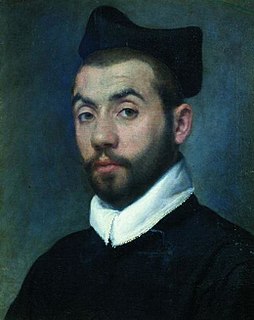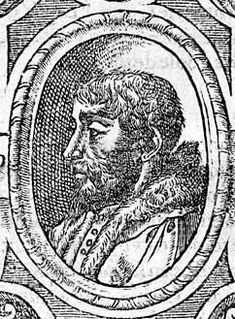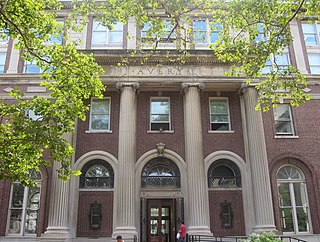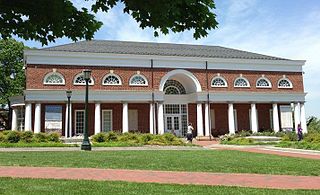Related Research Articles

In the history of printing, an incunable or incunabulum, is a book, pamphlet, or broadside that was printed in the earliest stages of printing in Europe, up to the year 1500. Incunabula were produced before the printing press became widespread on the continent and are distinct from manuscripts, which are documents written by hand. Some authorities include block books from the same time period as incunabula, whereas others limit the term to works printed using movable type.
Thoinot Arbeau is the anagrammatic pen name of French cleric Jehan Tabourot. Tabourot is most famous for his Orchésographie, a study of late sixteenth-century French Renaissance social dance. He was born in Dijon and died in Langres.

Clément Marot was a French Renaissance poet.

Maurice Scève, was a French poet active in Lyon during the Renaissance period. He was the centre of the Lyonnese côterie that elaborated the theory of spiritual love, derived partly from Plato and partly from Petrarch. This spiritual love, which animated Antoine Héroet's Parfaicte Amye (1543) as well, owed much to Marsilio Ficino, the Florentine translator and commentator of Plato's works.

The Beinecke Rare Book & Manuscript Library is the rare book library and literary archive of the Yale University Library in New Haven, Connecticut. It is one of the largest buildings in the world dedicated to rare books and manuscripts. Established by a gift of the Beinecke family and given its own financial endowment, the library is financially independent from the university and is co-governed by the University Library and Yale Corporation.

An emblem book is a book collecting emblems with accompanying explanatory text, typically morals or poems. This category of books was popular in Europe during the 16th and 17th centuries.

Claude Goudimel was a French composer, music editor and publisher, and music theorist of the High Renaissance.

The book of hours is a Christian devotional book popular in the Middle Ages. It is the most common type of surviving medieval illuminated manuscript. Like every manuscript, each manuscript book of hours is unique in one way or another, but most contain a similar collection of texts, prayers and psalms, often with appropriate decorations, for Christian devotion. Illumination or decoration is minimal in many examples, often restricted to decorated capital letters at the start of psalms and other prayers, but books made for wealthy patrons may be extremely lavish, with full-page miniatures. These illustrations would combine picturesque scenes of country life with sacred images. Books of hours were usually written in Latin, although there are many entirely or partially written in vernacular European languages, especially Dutch. The English term primer is usually now reserved for those books written in English. Tens of thousands of books of hours have survived to the present day, in libraries and private collections throughout the world.

The sea monk was a sea creature found off the eastern coast of the Danish island of Zealand in 1546. It was described as a "fish" that outwardly resembled a human monk in his habit. A 2005 paper concluded that the animal was most likely an angelshark.

Marguerite de Navarre, also known as Marguerite of Angoulême and Margaret of Navarre, was the princess of France, Queen of Navarre, and Duchess of Alençon and Berry. She was married to Henry II of Navarre. Her brother became King of France, as Francis I, and the two siblings were responsible for the celebrated intellectual and cultural court and salons of their day in France. Marguerite is the ancestress of the Bourbon kings of France, being the mother of Jeanne d'Albret, whose son, Henry of Navarre, succeeded as Henry IV of France, the first Bourbon king. As an author and a patron of humanists and reformers, she was an outstanding figure of the French Renaissance. Samuel Putnam called her "The First Modern Woman".

The Avery Architectural and Fine Arts Library is a library located in Avery Hall on the Morningside Heights campus of Columbia University in the New York City. It is the largest architecture library in the world. Serving Columbia's Graduate School of Architecture, Planning and Preservation and the Department of Art History and Archaeology, Avery Library collects books and periodicals in architecture, historic preservation, art history, painting, sculpting, graphic arts, decorative arts, city planning, real estate, and archaeology, as well as archival materials primarily documenting 19th- and 20th-century American architects and architecture. The architectural, fine arts, Ware, and archival collections are non-circulating. The Avery-LC Collection, primarily newer print books, does circulate.
Madeleine Des Roches was a French writer of the Renaissance. She was the mother of Catherine Fradonnet, called Catherine Des Roches, to whom she taught poetry, literature and ancient languages. She is a writer in the tradition of Christine de Pizan and others, working to establish a community of women writers.

Charlotte Guillard was the first woman printer of importance. Guillard worked at the famous Soleil d'Or printing house from 1502 until her death. Annie Parent described her as a "notability of the Rue Saint-Jacques", the street where the shop was located in Paris, France. She became one of the most important printers of the Latin Quarter area in the city of Paris. As a woman, she was officially active with her own imprint during her two widowhood periods, that is to say in 1519–20, and in 1537–57. While she was not the first woman printer, succeeding both Anna Rugerin of Augsburg (1484) and Anna Fabri of Stockholm (1496), she was the first woman printer with a significantly known career.
Andrew D. M. Pettegree is a British historian and an expert on the European Reformation, the history of the book and media transformations. He currently holds a professorship at St Andrews University where he is the director of the Universal Short Title Catalogue Project. He is also the founding director of the St Andrews Reformation Studies Institute.
The Universal Short Title Catalogue (USTC) brings together information on all books published in Europe between the invention of printing and the end of the sixteenth century, creating a powerful resource for the study of the book and print culture.

The Albert and Shirley Small Special Collections Library at the University of Virginia is a research library that specializes in American history and literature, history of Virginia and the southeastern United States, the history of the University of Virginia, Thomas Jefferson, and the history and arts of the book. The library is named after Albert and Shirley Small, who donated substantially to the construction of the library's current building. Albert Small, an alumnus of the University of Virginia, also donated his large personal collection of "autograph documents and rare, early printings of the Declaration of Independence." This collection includes a rare printing of the Dunlap broadside of the Declaration of Independence. Joining the library's existing Dunlap in the Tracy W. McGregor Collection of American History, Small's copy made U.Va. the only American institution with two examples of this, the earliest printing of the nation's founding document. It also includes the only letter written on July 4, 1776, by a signer of the Declaration, Caesar Rodney. The Albert H. Small Declaration of Independence Collection boasts an interactive digital display which allows visitors to view the historical documents electronically, providing access to children and an opportunity for visitors to manipulate the electronic copies without risk of damage to the original work.

Jean or Jehan Petit, in Latin Johannes Parvus, was a printer, publisher and bookseller in Paris. From 1493 to 1530 he printed about one tenth of all publications in Paris, more than ten thousand volumes.
Denis Janot was a printer and bookseller from Paris, France, whose store was near Notre Dame de Paris. Janot, who was born into a family of printers and booksellers and married into another such one, was notable for printing books in the vernacular, especially in the field of the humanities, and for commissioning illustrations for the books he printed. He is responsible for printing many of the notable classical authors as well as for contemporary ones, particularly in the matter of the Querelle des femmes, the contemporary discussion over the status of women.

The Rare Book & Manuscript Library at the University of Illinois at Urbana–Champaign (RBML) is located on the 3rd floor of the University Library. The library is one of the largest special collections repositories in the United States. Its collections, consisting of over half a million volumes and three kilometers of manuscript material, encompass the broad areas of literature, history, art, theology, philosophy, technology and the natural sciences, and include large collections of emblem books, writings of and works about John Milton, and authors' personal papers.
Claude Paradin, was a French writer, collector of emblems or "devises", historian, and genealogist.
References
- 1 2 Tarte, Kendall (October 30, 2017). "Readers Writing in the Gordon Collection Heptaméron". Itineraries in French Renaissance Literature: Essays for Mary B. McKinley. Brill. pp. 52–74. ISBN 978-90-04-35151-6 . Retrieved December 4, 2017.
- ↑ Persels, Jeff; Tarte, Kendall; Hoffmann, George (2017). "On Mary B. McKinley". Itineraries in French Renaissance Literature: Essays for Mary B. McKinley. Brill. p. 16. ISBN 978-90-04-35151-6.
- ↑ Walker, Paul; Martin, Rya (August 19, 2014). "A Long-Lost Partbook of French Chansons Resurfaces at the University of Virginia". Notes. 71 (1): 35–61. doi:10.1353/not.2014.0109. ISSN 1534-150X. S2CID 192115075 . Retrieved December 4, 2017.
- ↑ "Description of The Renaissance in Print project". University of Virginia Libraries. Retrieved December 5, 2017.